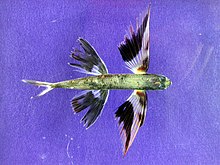Flying fish
Flying fish are marine oceanic fishes of the family Exocoetidae. They are over 50 species, and they live worldwide in warm waters. They can glide in the air just above the water.[1] They are all small, with a maximum length of about 45 cm (18 inches), and have winglike, rigid fins and an unevenly forked tail.
| Flyingfish | |
|---|---|
 | |
| Sailfin flying-fish Parexocoetus brachypterus | |
| Scientific classification | |
| Kingdom: | |
| Phylum: | |
| Class: | |
| Order: | Beloniformes |
| Family: | Exocoetidae |


They do not fly actively: their fins do not flap. What they do is speed towards the surface and keep on going. When they leave the water they glide, sometimes for a surprising distance. It is generally thought to be an adaptation which helps them escape predators.
The glides are usually up to 30–50 metres (100–160 ft) in length. Some have been observed soaring for hundreds of metres using the updraft on the leading edges of waves. The fish can also make a series of glides, each time dipping the tail into the water to produce forward thrust. The longest recorded series of glides, with the fish only periodically dipping its tail in the water, was for 45 seconds.[2]
It has been suggested that the genus Exocoetus is on an evolutionary borderline between flight and gliding. It flaps its enlarged pectoral fins when airborne, but still seems only to glide, as there is no hint of a power stroke.[3]
The earliest known flying fish were in the Middle Triassic.[4][5]